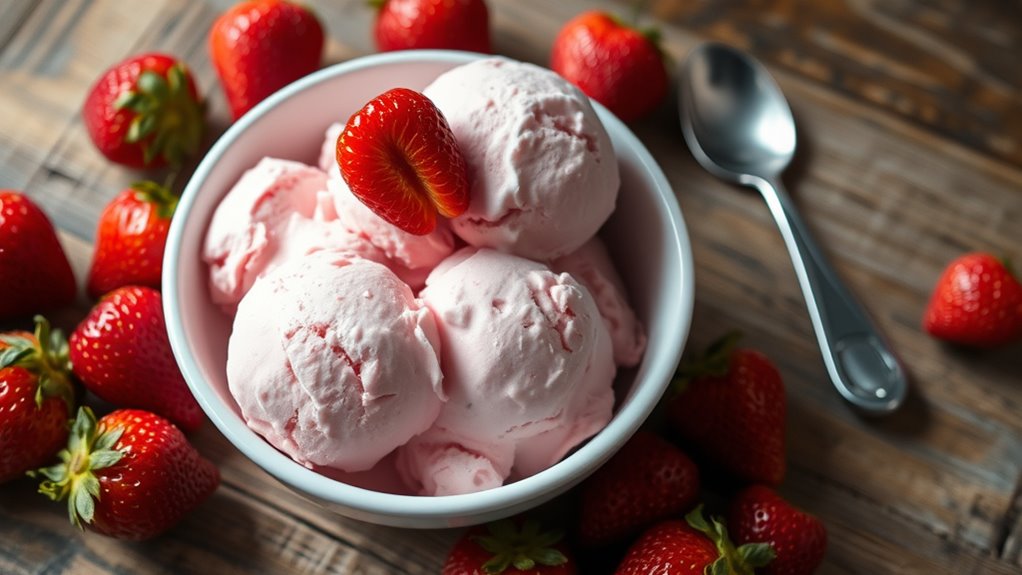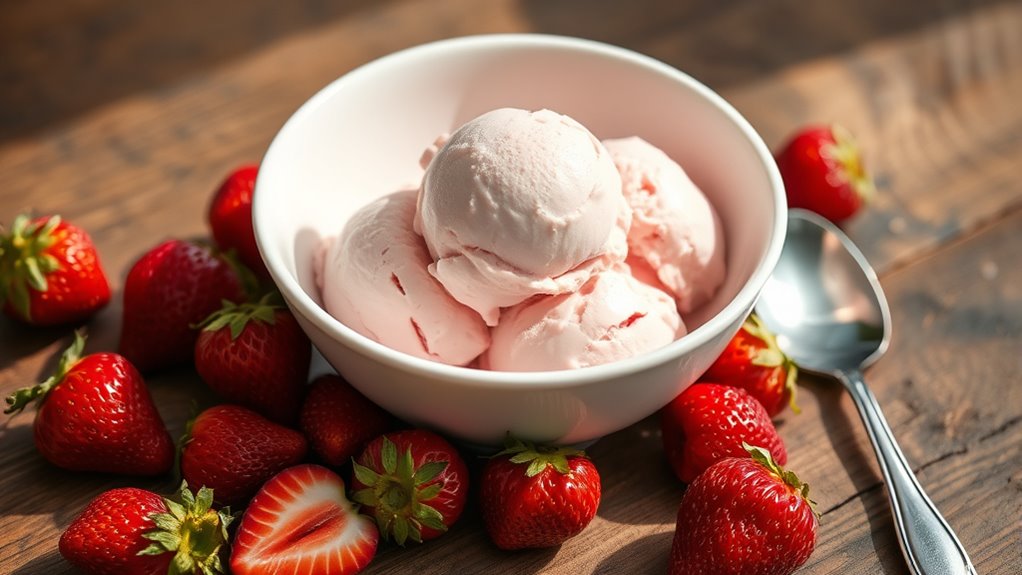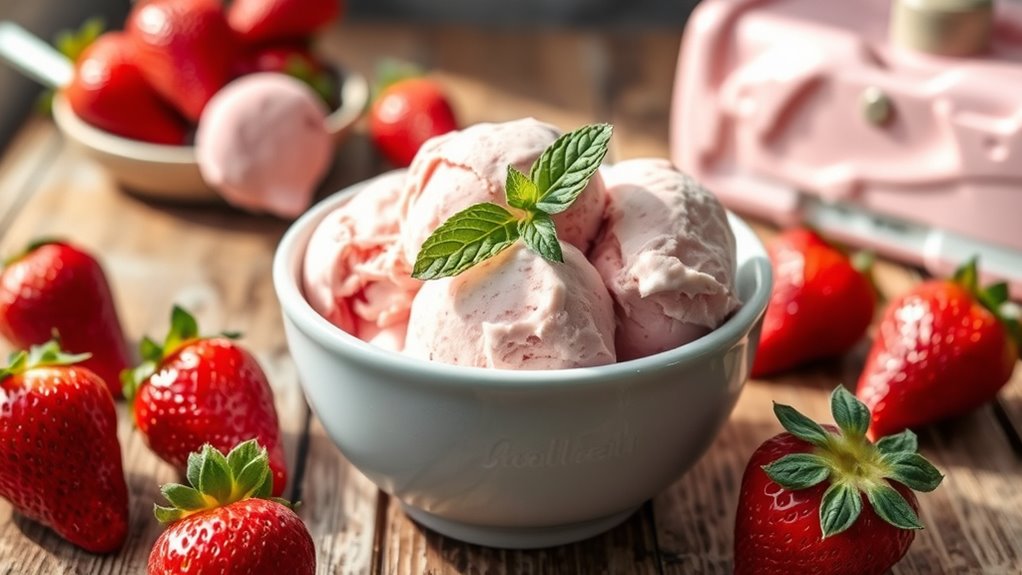For a creamy, sugar-free strawberry ice cream, blend 2 cups fresh, hulled strawberries with 1 cup heavy cream, 1 cup unsweetened milk, 2–3 tablespoons of a non-sugar sweetener, and 1 teaspoon vanilla plus a pinch of salt. Chill the base, pre-freeze your ice cream machine, and churn until smooth, then freeze promptly in an airtight container. Serve at slightly soft temperatures and pair with berries for contrast. You’ll gain practical steps and tweaks that make it repeatable and reliable.
Ingredients and Quantity

To make sugar-free strawberry ice cream, gather the following ingredients in precise quantities: ripe strawberries, 2 cups (about 300 g); 1 cup (240 ml) heavy cream; 1 cup (240 ml) unsweetened almond milk or dairy milk; 2–3 tablespoons erythritol, xylitol, or your preferred non-sugar sweetener, to taste; 1 teaspoon vanilla extract; and a pinch of salt.
| Ingredient | Quantity |
|---|---|
| Fresh strawberries | 2 cups (200–300 g) |
| Heavy cream | 1 cup (240 ml) |
| Liquid base | 1 cup (240 ml) |
| Sweetener | 2–3 Tbsp |
| Vanilla + salt | 1 tsp + pinch |
Fresh strawberries and low calorie sweeteners anchor a balanced, evidence-based base for freedom in flavor.
Preparations

Before you blend, prep all components to confirm a smooth process: wash and hull the strawberries, pat them dry, and measure the remaining ingredients. In this Preparations phase, focus on preparation techniques that minimize variability: portion all ingredients to exact gram or cup units, chill equipment, and set up your workstation for a seamless flow. Document any substitutions you plan to use, noting their impact on texture and sweetness. Emphasize ingredient sourcing: choose ripe, fragrance-rich berries and unsweetened dairy or dairy alternatives that align with your dietary goals. Keep a clean workspace to reduce contamination risk and confirm consistent results. Finally, verify measurements one last time, so you maintain reproducible texture, color, and flavor with every batch.
How to Cook

- Chill the ice cream base briefly before churning to reduce viscosity and ensure a smoother texture.
- Pre-freeze the ice cream machine bowl and any mixer attachments according to the manufacturer’s instructions.
- Combine ingredients in small batches to maintain temperature control and minimize lumping.
- Monitor heat carefully during cooking to keep custard temperatures within a safe range and prevent curdling.
- Whisk steadily to maintain a uniform emulsion.
- Use precise timing for chilling and freezing steps.
- Avoid overmixing to prevent ice crystal growth.
- Test ice cream texture by assessing spoon-to-scoop resistance.
- Adjust sweetener or stabilizer as needed to improve texture.
- Prioritize consistency, safety, and a velvety result without compromising flavor.
How to Serve

Serving options for sugar-free strawberry ice cream focus on texture, temperature, and presentation. You’ll want a scoopable yet creamy texture, achieved by briefly resting the churned base before serving and warming slightly if needed. For texture, consider a soft-serve scoop straight from the freezer with a brief 5-10 second counter softening, or pair with a contrasting element like fresh berries for bite. Temperature matters: serve at -6 to -8°C for structure, or -9 to -12°C for firmer scoops; monitor freezer drift and portion in small servings. Presentation ideas include clean bowls, minimal garnishes, and contrasting colors. Serving suggestions emphasize moderation in toppings and accessibility, ensuring your guests enjoy flavor without overwhelming sweetness or texture issues.
Tips

To get the best texture, chill the base thoroughly before churning and monitor the freezer’s temperature during storage. You’ll stay on track by following precise steps and using reliable equipment. Here are practical tips you can trust:
1) Use measured sugar substitutes to control sweetness without compromising texture or body.
2) Taste as you go, then adjust with small increments to avoid oversweetening.
3) Experiment with flavor variations like vanilla, lemon zest, or mint to keep batches distinct.
4) Freeze promptly after churning and store in an airtight container to minimize ice crystal formation.
This approach supports a concise, evidence-based method, balancing freedom in choice with reproducible results, so you can enjoy sugar substitutes confidently while exploring flavor variations.
Food Value and Benefit
Sugar-free strawberry ice cream offers valuable nutrition as part of a balanced diet. Made with real strawberries and low-sugar dairy or plant-based alternatives, it provides a good source of protein and healthy fats that promote satiety without added sugars. This dessert contains essential vitamins and minerals, including vitamin C, vitamin A, calcium, and potassium.
Benefits of eating sugar-free strawberry ice cream include:
Benefits include steady energy, fullness, antioxidants, and essential nutrients from strawberry ice cream without added sugars.
- Supports steady blood sugar levels by minimizing added sugars
- Promotes fullness and reduces overeating due to protein and healthy fats
- Provides antioxidants from strawberries that help combat oxidative stress
- Supplies dietary fiber, aiding digestion and gut health
- Contains essential micronutrients such as vitamin C for immune support and calcium for bone health
- Helps maintain consistent energy and mood by avoiding sugar-induced energy spikes
Frequently Asked Questions
Can I Use Dairy-Free Milk Instead of Dairy?
Yes, you can. Dairy-free milk works as a substitute if you choose unsweetened options. For best texture, blend with a small amount of thickener. Consider dairy free alternatives and milk options like almond, oat, or coconut.
Will It Melt Quickly After Churning?
Yes, it won’t melt instantly; with dairy-free milk, texture stability improves if you chill thoroughly and churn steadily. You’ll notice melting point is gradual, not sudden, giving you repeatable, evidence-based control for crisp, freedom-loving enjoyment.
Can I Add Mix-Ins Like Berries?
Yes, you can add mix-ins like berries. Choose momentarily frozen, bite-sized berry types for even distribution, then fold gently. Try mix in options such as raspberries or blueberries; make certain they’re dry to prevent ice crystallization and sogginess.
How Long Is the Ice Cream Shelf-Stable?
Shelf life depends on storage: you’ll keep it best at -18°C (0°F) for about 1–2 months. For ice cream storage, avoid thaw-refreeze cycles; seal tightly and use quick-freeze methods to maintain texture and safety.
Is There a Sugar Substitute That Tastes Fruity?
Yes. About one in five people prefer fruit sweeteners, and there are fruity-tasting options. You’ll note a subtler taste difference in taste comparison, but many find fruit sweeteners satisfy craving without compromising texture or freedom.
